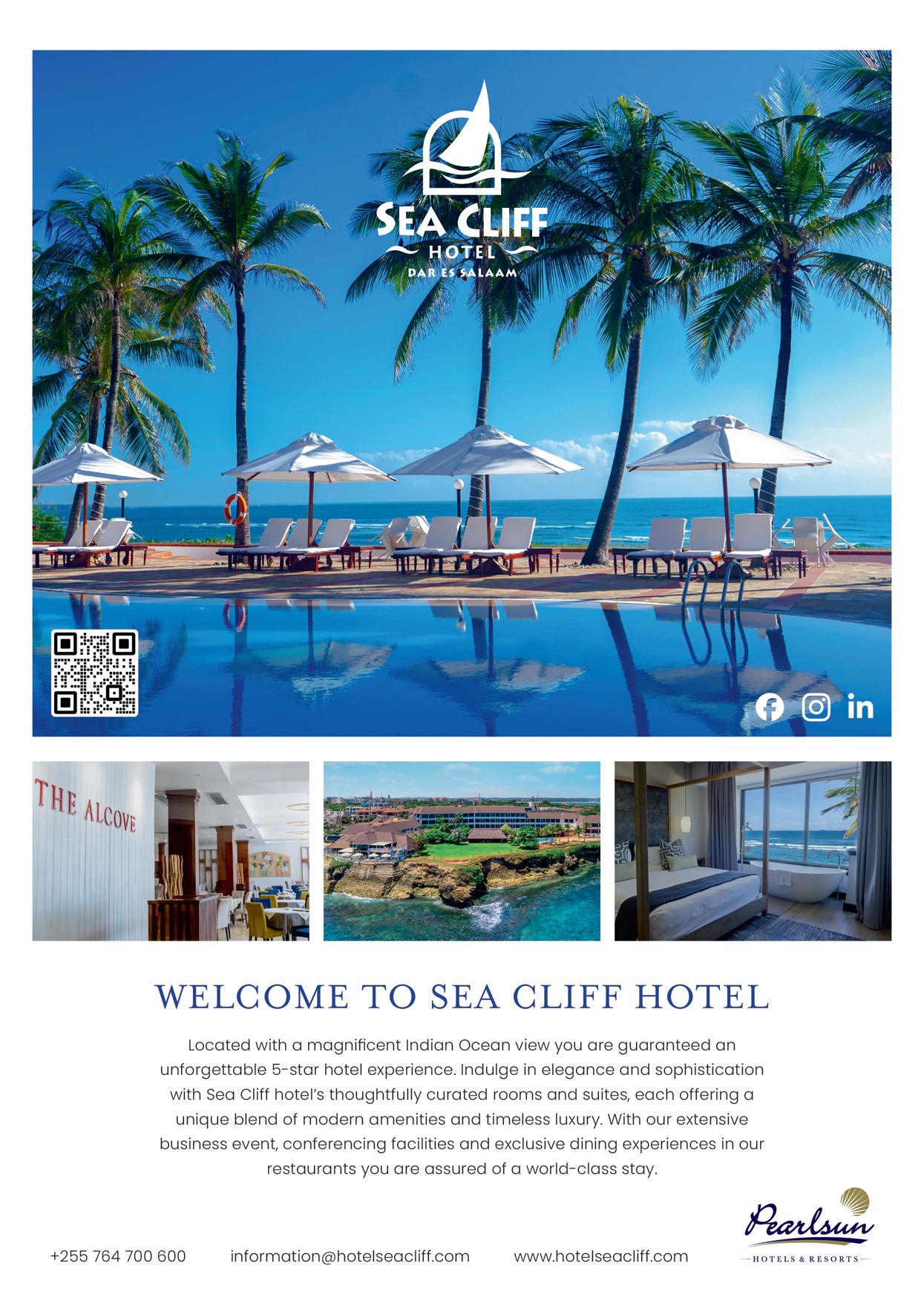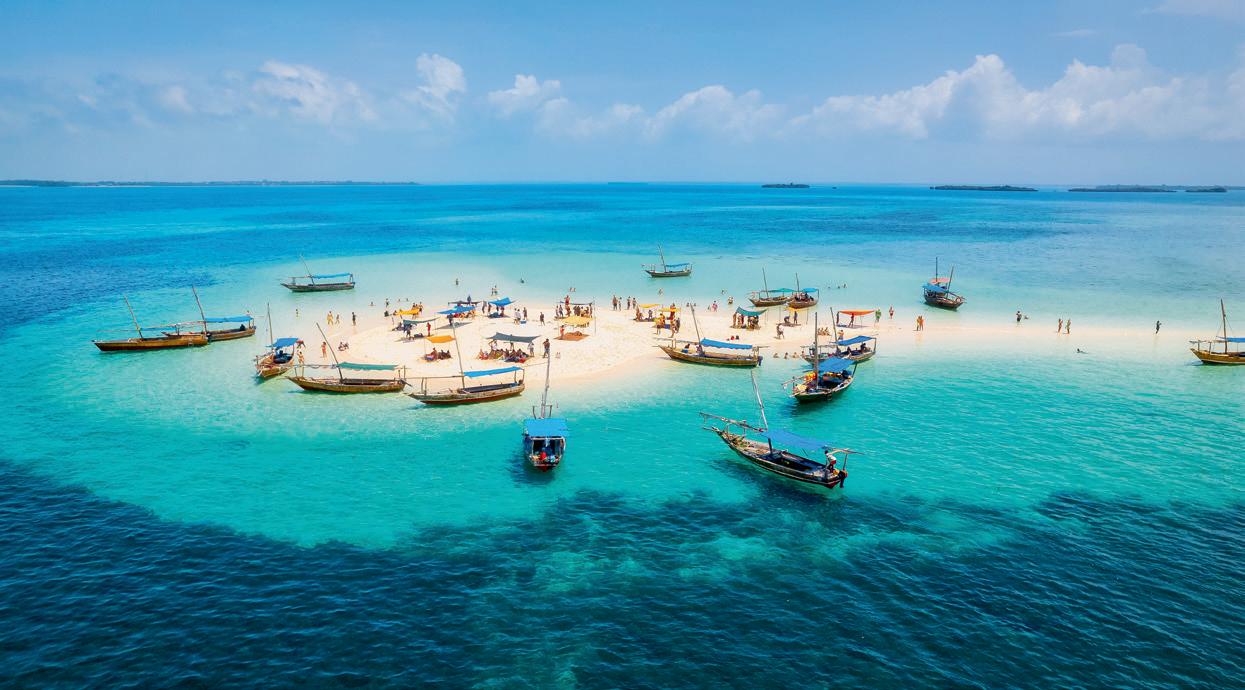
MEMORIES THAT LAST FOREVER
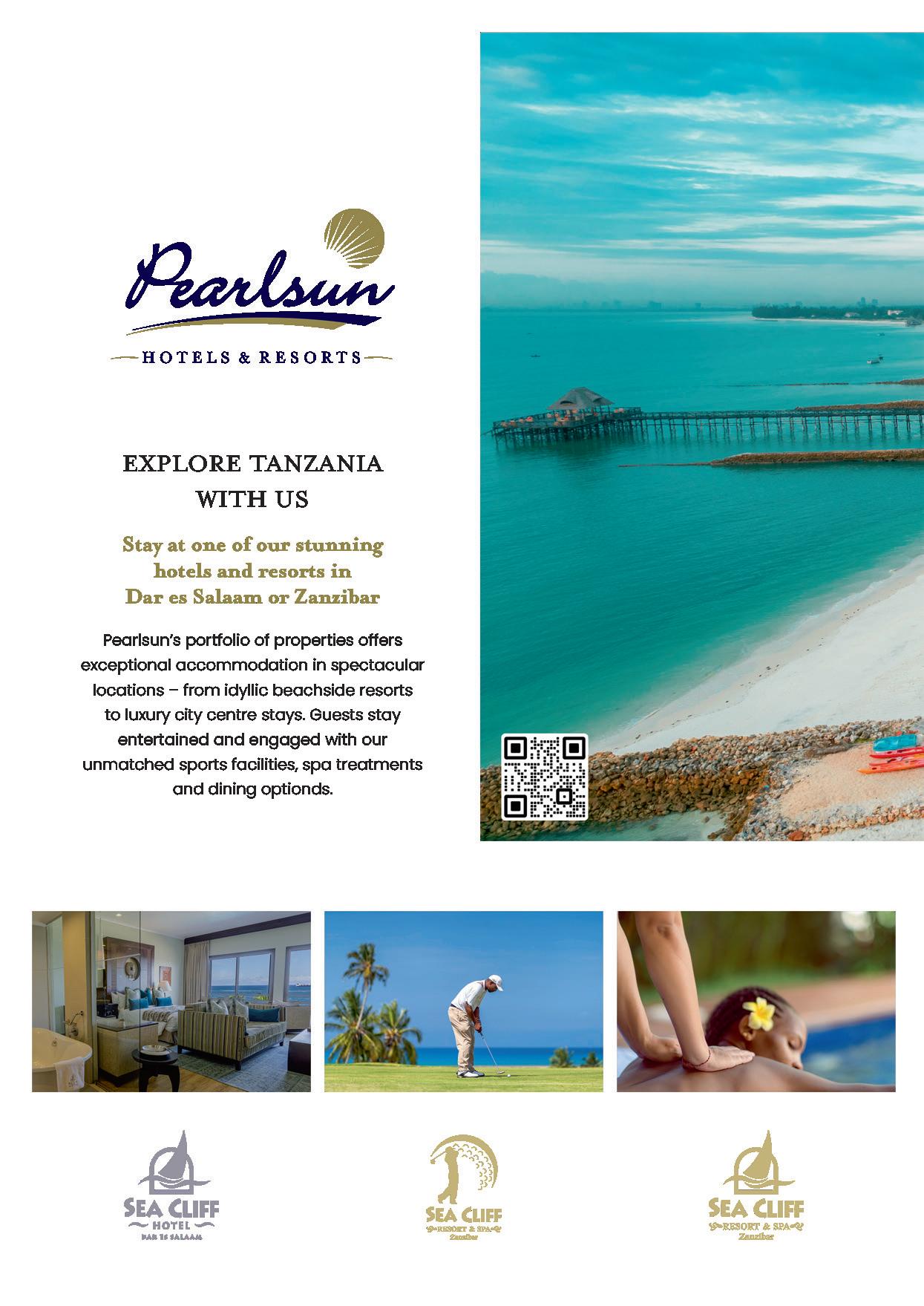

SEA CLIFF RESORT & SPA , Zanzibar




SEA CLIFF RESORT & SPA , Zanzibar
With its own sense of the past, explore these authentic back streets

WHITE SANDS RESORT & CONFERENCE CENTRE
Dar es Salaam
Occupying an idyllic stretch of private beach north of Dar es Salaam, the White Sands Resort & Conference Centre has been a much-loved escape for city residents for more than 30 years

SEA CLIFF RESORT & SPA
Zanzibar
Zanzibar – with its white sand beaches, coral reefs, bountiful spices, and diverse culture –deserves to be explored, and Sea Cliff connects guests with a host of adventures that reveal the island’s unique magic.

SEA CLIFF COURT HOTEL & LUXURY APARTMENTS
Dar es Salaam
With its spacious and well-appointed rooms with kitchenettes, Sea Cliff Court Hotel & Luxury Apartments is perfect for longer stays in Dar es Salaam.

SEA CLIFF HOTEL
Dar es Salaam
Sea Cliff Hotel offers destination dining in Dar es Salaam. We speak to the culinary creatives behind the hotel’s two top-class restaurants – Karambezi Café and Alcove Restaurant.
Neelkanth
P O Box 3030 Sewa Street, City Centre Dar es Salaam,
seacliffcourt.com hotelseacliff.com
Email: info@pearlsunhotels.com
Tel: +255 22 2139158
Fax: +255 22 2117963 Read



Welcome to the first edition of Pearlsun Hotel & Resorts magazine. The annual luxury travel and hospitality publication is now available in every room within our portfolio of the finest hotels, beach resorts and serviced apartments in Dar es Salaam and Zanzibar.
Inside you’ll find articles that showcase the wealth of luxurious touches and upscale amenities that elevate the guest experience at White Sands Resort & Conference Centre, Sea Cliff Hotel Dar es Salaam, Sea Cliff Resort & Spa, Zanzibar, and Sea Cliff Court Hotel & Luxury Apartments.
We have also curated a range of ideas for guests who want to discover and engage with the unique culture, history, and character of Tanzania and Zanzibar.
Championing our country comes easy. Pearlsun is part of a family-run Tanzanian conglomerate that began with just one shop in Dar es Salaam in 1994. We have deep roots in the region so the
fact that 2024 was a record year for tourism in Tanzania fills us with pride. In support of the country’s bid to boost the tourism sector even further, this magazine reveals some lesser-known gems among the Tanzanian treasure chest of attractions – all within easy reach of a stay with us.
Pearlsun is putting in place a series of renovations that will elevate our renowned guest experience to unparalleled levels. At White Sands a full renovation of the bathrooms along with a soft refurbishment of the rooms and public areas has been completed. At Sea Cliff Zanzibar bathroom renovations are currently underway while over at Sea Cliff Court a complete renovation has refreshed all rooms and the lobby area. A full renovation is also taking place at Sea Cliff Dar es Salaam.

Enjoy our hotels, enjoy our country. We are delighted to host you.
Veer Patel, Executive Director, Pearlsun Hotels & Resorts

WHITE SANDS RESORT & CONFERENCE CENTRE, Dar es Salaam
Luxury resort has been favourite Dar beach escape for more than 30 years
Occupying an idyllic stretch of private beach north of Dar es Salaam, the White Sands Resort & Conference Centre has been a much-loved escape for city residents for more than 30 years with past guests including sports stars, politicians and diplomats. Some staff who remember those early days are still working at the hotel today. They share their memories of the hotel and how its importance to the local community has remained unchanged even as the luxury resort has grown through extensive enhancements and renovations.
White Sands Hotel first opened its doors in November 1993. The then three-star hotel featured 88 beach view guest rooms, a conference hall, a restaurant, a casino & nightclub and an outdoor pool. Set on a private stretch of Jambiani Beach around a 30-minute drive north from the centre of Dar es Salaam, the hotel has become one of the commercial capital’s first beach resorts. Leisure and business visitors loved that the hotel was in easy reach of the city but felt like a world away in its serene beach life and uninterrupted views of the sapphire waters of the Indian Ocean.
Fast forward more than 30 years and the White Sands Resort & Conference Centre is still very much a premier attraction. Now with a four-star rating and flanking an even longer stretch of private beach lined



with thatched sunshades, it boasts 143 ocean-view rooms, including an impossibly opulent Presidential suite. Other new facilities include a new restaurant, another swimming pool and a series of indoor and outdoor photogenic wedding party spaces including an Instagram-ready jetty reaching out over the water. Over the decades the resort’s business facilities have been majorly upgraded to offer 15 meeting rooms for up to 350 guests.
Some things haven’t changed. There are still a few members of the hotel’s 250-strong workforce who were here at the time of the 1993 launch and have worked their way up to more senior positions today and share in the hotel’s growth and success. Among
Leisure and business visitors loved that the hotel was in easy reach of the city but felt like a world away in its serene beach life and uninterrupted views of the sapphire waters of the Indian Ocean.
From its earliest days, the hotel has not just been a place for visitors to stay, but a business that supports and uplifts the surrounding area.

these stalwart staff members are Kunda Manase, who began as a storekeeper in 1993 and is now an assistant housekeeper; Flora Sondo, who joined as a pastry chef in 1997 and has progressed to be part of the reservations team; and Devota Malango, who since starting in 1995 has gone from being a room attendant to floor supervisor.
Dorah M Mfuru, who was a secretary at White Sands when the hotel launched and has gone on to work in the accounts department, says it has been a “privilege to share in the remarkable journey of Hotel White Sands”.
“I’ve had the honour of being part of this transformation since its humble beginnings in November 1993, and it’s been nothing short of an incredible experience for three decades.
“My journey at Hotel White Sands began in 1993 when I was employed as a secretary. I took great pride in supporting the daily operations and ensuring that communication flowed smoothly between departments. As the hotel grew, so did my role. I transitioned to becoming an accounts assistant where I was able to make use of my skills in a more analytical and detail-oriented capacity. This change

marked a significant shift in my career, as I took on more responsibilities by meeting different clients and became part in the hotel’s continued success.”
Dorah has seen White Sands become Dar’s top choice for high-profile meetings and events with its excellence recognised at the World MICE Awards in 2023 when it was named Best MICE Hotel. Among her stand-out memories is the event that started it all.
“The Miss Tanzania Pageant in 1994 was the very first time we hosted a large event at the hotel,” she says. “I remember Miss Aina Maeda emerged as the winner. This was a historic moment, as it marked the first time the pageant was held at the hotel’s lovely Gilmans Hall. The excitement and pride among the staff team were superb, and it was amazing to witness the hotel making a mark in the country’s history by hosting such an iconic event. The glamour and energy of the night were unforgettable, and it was a defining moment for all of us involved.”
Interviewed collectively, Kunda, Flora and Devota, recall some of the memorable international guests White Sands has welcomed. “We remember among our first clients was the Stella Adjame football team from Cote D’Ivoire that were playing a match here. We also catered for airline crews from Lufhansa, Air India and Swiss International,” they say.
Since then, Dorah has seen many distinguished guests enjoy the garlanded White Sands hospitality. “My favourite guest among them was the former President of Tanzania Jakaya Kikwete. In those days he was a minister before he was elected our fourth president. We also hosted a spectacular birthday party for [second President of Tanzania] Ali Hassan Mwinyi.”
The former Governor of the Bank of Tanzania, Gilman
Rutihinda, who the hotel’s 300-capacity conference venue Gilmans Hall is named after, is also fondly remembered.
White Sands manages to be both an exclusive venue that has prominent politicians among its clientele as well as a venue with options for everyday Tanzanians.
Locals know the hotel for its Water World fun park, which has been a hugely popular day out in Dar for decades. On the White Sands site, yet enclosed from the rest of the resort, the collection of water slides, pools and fountains is free to enter for guests but also open to the public with prices kept deliberately low to welcome all. Seeing Water World take shape and become a place of fun in the sun for generations of Tanzanians is a “cherished memory” for Dorah.
“I remember the initial excitement. It was thrilling to see families enjoying the park, and it was clear that this addition had a profound impact on both the hotel and the local community,” she says.
Kunda, Flora and Devota also fondly remember former facilities at the White Sands that enchanted locals. “The night club, casino and cinema hall were also special places to enjoy.”
The connection between White Sands and the community runs deep. As Dorah, Kunda, Flora
and Devota can attest, the resort creates career opportunities for its staff as well as supporting the wider domestic economy. “From its earliest days, the hotel has not just been a place for visitors to stay, but a business that supports and uplifts the surrounding area,” Dorah says. “The hotel is proud to source many of its products from local suppliers, including food and general goods. By purchasing from local farmers, markets, and suppliers, we help boost the regional economy and ensure that the hotel’s business remains connected to the heartbeat of Dar es Salaam.”
Looking to the resort’s future after celebrating its past, Dorah sees the good work continuing. “The White Sands Resort and Conference Centre is committed to making a positive impact on the lives of those around us.”
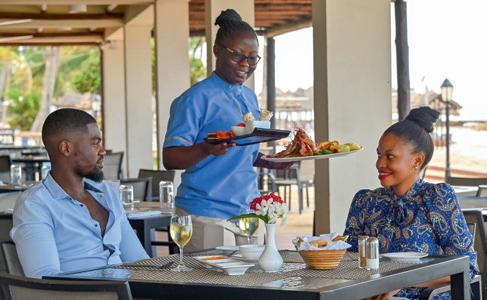

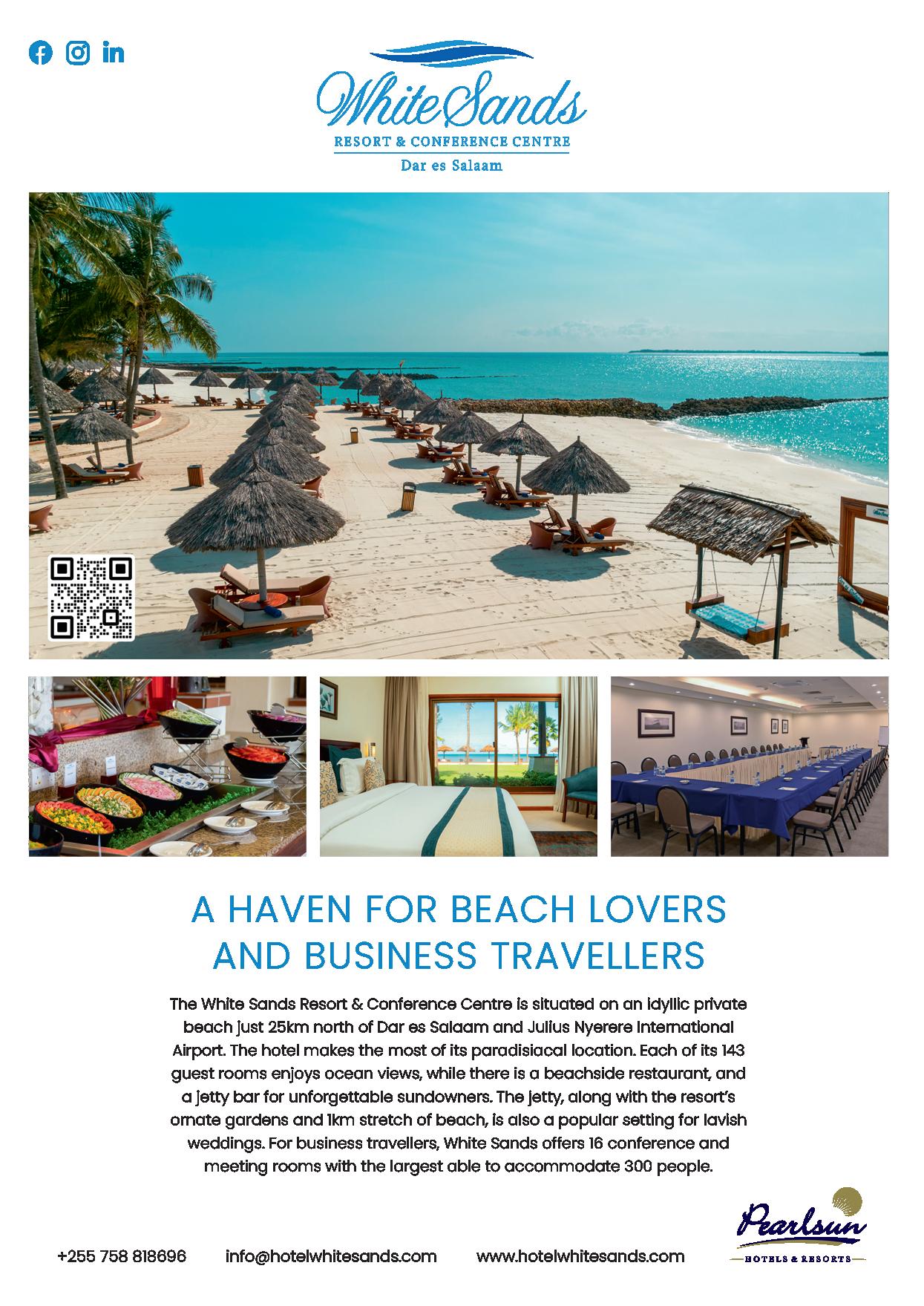
143
The number of guest rooms at White Sands. Each has a sea view. The number includes 118 superior sea view rooms, four studio apartments, sixteen one-bedroom apartments, and four sea-facing and four garden-facing twobedroom apartments with a balcony. All rooms are air-conditioned and have complimentary Wi-Fi throughout.
300
The number of guests that can be accommodated theatre-style in White Sands’ largest conference room, Gilmans Hall. The hotel boasts 16 venues to host events from large-scale banquets to small classroom events. The wealth of facilities makes White Sands one of the leading MICE venues in Dar es Salaam.
9am to 9.30pm
The opening hours of the café at the end of Pweza Jetty, one of White Sands’ most recent and popular features. Here guest can enjoy light meals and a full bar service while taking in the Indian Ocean views –particularly special at sunset.




4
The number of varieties of non-motorised water transport available for White Sands’ guests to use for free. Choose from windsurf boards, laser and catamaran sailboats or kayaks. All manner of water sports activities can be outsourced.
1 km
The length of the pristine private beach at White Sands.
1,154 sq m
The size of the gym at White Sands. That huge space is filled with the latest cardio and resistance equipment. Best of all, it is beach side with huge windows so you can feast your eyes on the Indian Ocean as you work out.
300
The number of people that can be seated at the resort’s Mchanga Restaurant. Open for breakfast, lunch and dinner, the beachside restaurant – its name means ‘sand’ in Swahili – offers an à la carte menu as well as buffet-style dining options.


Pearlsun Hotels are among Tanzania’s most enchanting wedding destinations, offering beachside ceremonies, lush garden receptions, and exquisite dining experiences
Since 2019, award-winning wedding planner Kajal Patel has been turning dream weddings into reality through her company, Events By Kajal. “My ultimate goal is to create a wedding experience that evokes deep emotions of joy, love, and connection for both the couple and their guests,” she says.
Award-winning wedding planner Kajal Patel has been curating unforgettable luxury celebrations since 2019 through her renowned company, Events By Kajal. Her signature touch? Crafting deeply emotional and visually stunning experiences that resonate with love, joy, and connection.

With clients from the Zambia, Kenya, USA, UK, India, Dubai and South Africa, Kajal specializes in destination weddings in the breathtaking coastal havens of Tanzania and Zanzibar—true gems for those seeking elegance, privacy, and natural beauty.
Her preferred venues, including the White Sands Resort by Pearlsun Hotels and the Sea Cliff Zanzibar Resort & Spa, boast pristine beaches, infinity pools, tropical gardens, and exclusive wedding spaces like the Pweza Jetty and Kole Kole pier.
Kajal Patel masterfully blends elegance with the natural charm of coastal venues by incorporating nautical-inspired décor such as driftwood, seashells, and ambient candlelight. Her events often include thoughtful post-ceremony touches—sunset photoshoots, beachfront bonfires, or relaxed cocktail hours by the sea. For garden weddings, she creates enchanting pathways lined with flower arches, trellises, hanging greenery, and soft lighting, transforming every setting into a magical scene.


From intimate gatherings to lavish, multi-day celebrations hosting up to 1,800 guests, Kajal and her team tailor each experience with care. Personalised details are at the heart of every event, reflecting the couple’s style, story, and vision. “I want each couple to feel completely immersed in the magic of their day, surrounded by moments that are uniquely theirs,” she says.
Kajal Patel is known for her storydriven approach to wedding design, where every detail is carefully curated to reflect the couple’s personality and vision. One memorable celebration involved transforming an industrial venue into a romantic, vintage-inspired space with a modern edge. “We combined antique furniture, soft vintage lighting, and lush florals with sleek, contemporary elements,” Kajal recalls. “The highlight was a cascading floral installation above the reception table—dramatic, elegant, and unforgettable.” A mix of vintage chairs completed


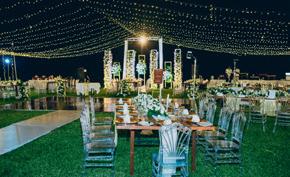

the relaxed, eclectic look, creating a setting that felt both timeless and fresh.”
Each year, Kajal and her team orchestrate around 20 bespoke weddings, ranging from lavish multi-day Indian celebrations to intimate Western ceremonies.
Many couples also choose to weave in Swahili coast traditions— from vibrant dancing and henna art to culinary delights like nyama choma, pilau, and mandazi.
“These cultural touches not only honour the local heritage but also bring a wonderful sense of joy and community to the day,” Kajal explains.
Regardless of size or style, Kajal ensures her clients can fully immerse themselves in the moment. “We manage every aspect behind the scenes—timing, logistics, coordination—so the couple and their guests can truly relax and enjoy,” she says.
Does she still find time to soak in the magic herself? “Absolutely,” Kajal smiles. “It’s such a privilege
to witness the beauty of the day as it unfolds—the first dance, the walk down the aisle—those emotional, unforgettable moments make all the hard work worthwhile. Helping create a day that will be cherished forever is why I do what I do.”
Those emotional, unforgettable moments make all the hard work worthwhile. Helping create a day that will be cherished forever is why I do what I do.


• For details on wedding packages at White Sands, visit www.hotelwhitesands.com/weddings/
• For details on wedding packages at Sea Cliff Zanzibar, visit www.seacliffzanzibar.com/weddings-events/wedding-packages/
• To connect with Events By Kajal, visit @eventsbykajal on Instagram
SEA CLIFF RESORT & SPA , Zanzibar
One of the best ways to connect with a culture is to share a meal with the locals. That’s the thinking behind the Swahili cooking sessions at the Sea Cliff Zanzibar Resort & Spa. Head chef Rajiv Boodan reveals how the regular events are a fun way to create (and taste) phenomenal dishes.
Zanzibar is a cosmopolitan archipelago built on centuries of trade along East Africa’s Indian Ocean coastline. That international fusion is reflected in the islands’ cuisine which draws on African, Arab, Persian, and Indian influences while making the most of what the bountiful land and ocean have to offer.
For Rajiv Boodan, head chef at Sea Cliff Resort & Spa Zanzibar, food here is a gateway for gourmands to learn about and appreciate Swahili culture. “Our flavourful and diverse culinary tradition reflects the history and culture
of the Swahili coast,” he says. “It’s a fusion of, blending fresh local ingredients with spices and herbs brought by traders and explorers over the centuries. Dishes are known for their bold flavours, with a heavy emphasis on seafood, coconut, and various spices. Swahili cuisine also places a lot of value on communal eating, with many dishes served in a shared style, creating a warm, social experience.”
This unifying power of food is at the heart of the cookery sessions the hotel organises that give guests the opportunity to


create and taste classic Swahili dishes. Set up by the side of the hotel’s beautiful outdoor pool, the sessions are fun, welcoming and teach guests the skills to whip up a Swahili favourite to impress friends and family at home. Rajiv says: “Guests have the opportunity to cook alongside our chefs, learning the techniques behind popular Swahili dishes, such as chicken curry with coconut milk, pilau, and Samaki wa kupaka (grilled fish with coconut sauce). The open-air environment and stunning coastal views make it a memorable experience.”
Many of the guests at these sessions will have also experienced the tour of local spice farms the hotel also organises. For centuries, Zanzibar’s spice farms have produced cloves, cinnamon, cardamom, nutmeg, ginger, black and white pepper, vanilla and lemon grass. Guests at the cooking sessions will find out how these ingredients provide the flavour, warmth, and depth of Swahili dishes.

At Sea Cliff Zanzibar, we pride ourselves on offering guests a taste of local culture, and our restaurant menu reflects that.
“Spices are absolutely essential in Swahili cuisine,” says Rajiv. “They are woven into the fabric of many traditional dishes. These spices not only add depth and complexity to the flavours, but they also reflect the history of the region, where traders from various parts of the world introduced these aromatic ingredients. In our cooking

sessions, we highlight the role of spices, letting guests experience their vibrant flavours firsthand, especially after they’ve just visited the spice farms.”
The sessions are hands-on with guests encouraged to get involved in preparing dishes from scratch. “One of the most exciting aspects of our cooking sessions is that
guests get to see the dishes come to life from start to finish,” Rajiv says. “We begin by introducing the ingredients, explaining their origins, and then we move on to the preparation process. Guests are encouraged to participate in chopping, mixing, and even cooking some of the dishes. It’s a truly interactive. Of course, tasting comes at the end.”
All the dishes prepared are Swahili specialities that locals love, but, if pressed, which is Rajiv’s favourite?
“It’s difficult to choose just one, but I do love chicken coconut curry. The combination of fresh local chicken, the creamy coconut sauce, and the spices is simply irresistible. It’s a great representation of Swahili cuisine because it combines the fresh produce of the Island with the bold flavours brought by the spice trade.”
If you are not able to attend the cookery sessions, you can still get a taste of Swahili cuisine at Sea Cliff Zanzibar Resort & Spa as the on-site Mangapwani Restaurant has many classic local dishes on its menu. “At Sea Cliff Zanzibar, we pride ourselves on offering guests a taste of local culture, and our restaurant menu reflects that,” says Rajiv. “Dishes like biryani, pilau, and grilled fish are frequently served at the hotel’s main restaurant, with a focus on fresh, local ingredients. We want guests to experience authentic Swahili cuisine not only during the cooking events but throughout their stay.”
For more details on the food options at Sea Cliff Zanzibar Resort & Spa, visit seacliffzanzibar.com

120
The total number of guest rooms at the resort.
96
The number of those rooms that have a sea view. The remainder look out over the resort’s tropical gardens.
30 acres
The approximate size of the resort’s grounds. The site includes facilities such as two infinity pools, a fully equipped gym, floodlit tennis courts, a kids’ club and a private beach with jetty.
5
The number of treatment rooms at the onsite Zuri Rituals Spa. This haven of tranquillity features a couple’s massage room, sauna and steam room.
4
The number of dining options set in the resort’s luxury surroundings. Choose from The Mangapwani for local or international buffet; the Karibu or Starehe Lounge for light meals.




The Kobe Bar is the place for casual dining. A drink or two? Head to the Zanzi-Bar for a more formal evening or the Jetty Bar for sundowners and cocktails.
25 minutes
The time taken for a car journey from Zanzibar International Airport to the hotel.
9am to 1pm
The respective outbound and return times for the free shuttle bus connecting resort guests with the hub of history, culture and entertainment that is Stone Town.
1
The number of golf courses in Zanzibar. The home of this unique sporting venue is Sea Cliff Resort & Spa.
200
The number of guests that can be accommodated at the exclusive events venue, the Boma. The oceanside venue, featuring a traditional Zanzibari makuti roof is a popular place for events from business conferences to weddings.


Among the wealth of luxury facilities available to guests at Sea Cliff Resort & Spa Zanzibar is a nine-hole golf course - the only one of its kind on the archipelago. The hotel’s golf manager, Elias Soka, reveals how the pro-designed course attracts guests, international tournaments and a new generation of young local players.
A dream come true…
Elias says: “Sea Cliff Resort & Spa Zanzibar offers many in-house activities. Having a golf course was one of the owner’s dreams, aimed at providing a unique experience for our guests and visiting golfers. That dream came true when the golf course was officially opened on February 15, 2015.
Designed by a professional golfer…
The course was designed by Peter Matkovich, who was a professional golfer on the European circuit as well as one-time caddie for golfing legend Gary Player. The Zimbabwean has gone on to a second career as a golf course architect. He designed 25 original 18-hole courses in Southern

Africa as well as two in Mauritius and nine-hole courses in Zanzibar and Malawi.
Special features of the course…
Elias says: “We have an undercover driving range and practice greens, all with opportunities to take in the island’s natural features. We offer a fully equipped pro shop and electric golf carts for your convenience. A resident pro is available to help you perfect your swing. Additionally, our sea-view clubhouse restaurant features a private beach. To top it all off, the last two holes are played alongside the stunning Indian Ocean.”
A challenge for golfers of all levels…
Elias says: “Hole 8/17 [the course has nine holes, but different tee settings allow it to be played as a Par 71 18 holes] is a Par 4 and one of the toughest holes on the course. It plays into the prevailing wind and is lined with numerous obstacles, including bunkers, mounds, and a mangrove river on the left side of the fairway.”
The Sea Cliff Zanzibar course has its own resident pro, who, Elias says, in July 2022 carded a score of 65, the lowest ever recorded score

here over 18 holes. He is available to give lessons to golfers. Elias adds: “We also have one caddy who is qualified to give beginner guest lessons.”
Open to all…
The course is open and available for hotel guests, visitors from other hotels, and

residents. Hotel guests receive preferential rates.
The club hosts monthly golf events as well as the CEO Golf Day which attracts international competitors. There are also regular charity golf days.
Elias says: “The Sea Cliff golf course is set in a tropical landscape, featuring magnificent mango trees and towering palms. It borders a beautiful mangrove swamp and is flanked by coastal low dunes landscape along the
Even if golf is not your game, Pearlsun Hotels & Resorts have a huge range of sporty options for a healthy break.
SEA CLIFF RESORT AND SPA ZANZIBAR
• Squash, tennis, and pickleball courts.
• Well-appointed gym.
• Bicycles free to hire.
• Two infinity swimming pools, a kids pool and a kids club
• Diving centre
• Mini-golf course
• Large gym with ocean views
• Two outdoor pools
• Beach volleyball
• Water sports, including windsurfing, laser and catamaran sailing or kayaking.
• Non-motorized water sports are available free of charge to hotel residents. Two jet-skis are also available.
SEA CLIFF HOTEL DAR ES SALAAM
• Fitness centre equipped with cardio and resistance machines and free weights.
• Personal trainers available.
• Outdoor swimming pool
SEA CLIFF COURTS
• Outdoor swimming pool
• 24-hour fitness centre
ocean on a couple of holes. A vibrant ecosystem thrives here. The water feature at the third hole attracts more than 45 types of birds and various marine creatures. This makes for a dynamic and lively golfing environment where nature and sport intertwine harmoniously.”
“After a day on the greens, golfers can relax and unwind on the Clubhouse veranda. Situated on a private beach, this spot offers spectacular views of the ocean, making it the perfect place to enjoy the stunning Zanzibar sunset.”


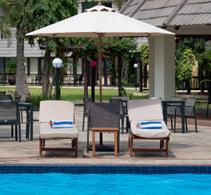

Elias says: “The club has had a program in place since 2021 in which our pro conducts free clinics for local kids interested in golf. To date, we have successfully developed nine junior golfers who are actively playing and have established their handicaps. Last year, they participated in the Tanzania Amateur Golf event in Dar es Salaam and won.”
For more details on the Sea Cliff Zanzibar Golf Club and to make bookings, visit seacliffgolf.com or call +255 758848840
A little-known slice of local history that was in danger of being lost forever.


Young people in Dar es Salaam, one of the fastest growing cities in the world, grow up knowing only its urban sprawl but there is a generation that lives here that remembers a different, more pastoral Dar with five pristine lakes at its heart. In her documentary The Lost Lakes of Dar es Salaam, local filmmaker Aika Kirei (above) preserves a little-known slice of local history that was in danger of being lost forever.
Tanzania’s commercial capital Dar es Salaam is one of the fastest growing cities in the world. New film The Lost Lakes of Dar es Salaam documents just how quickly things can change here. In interviews
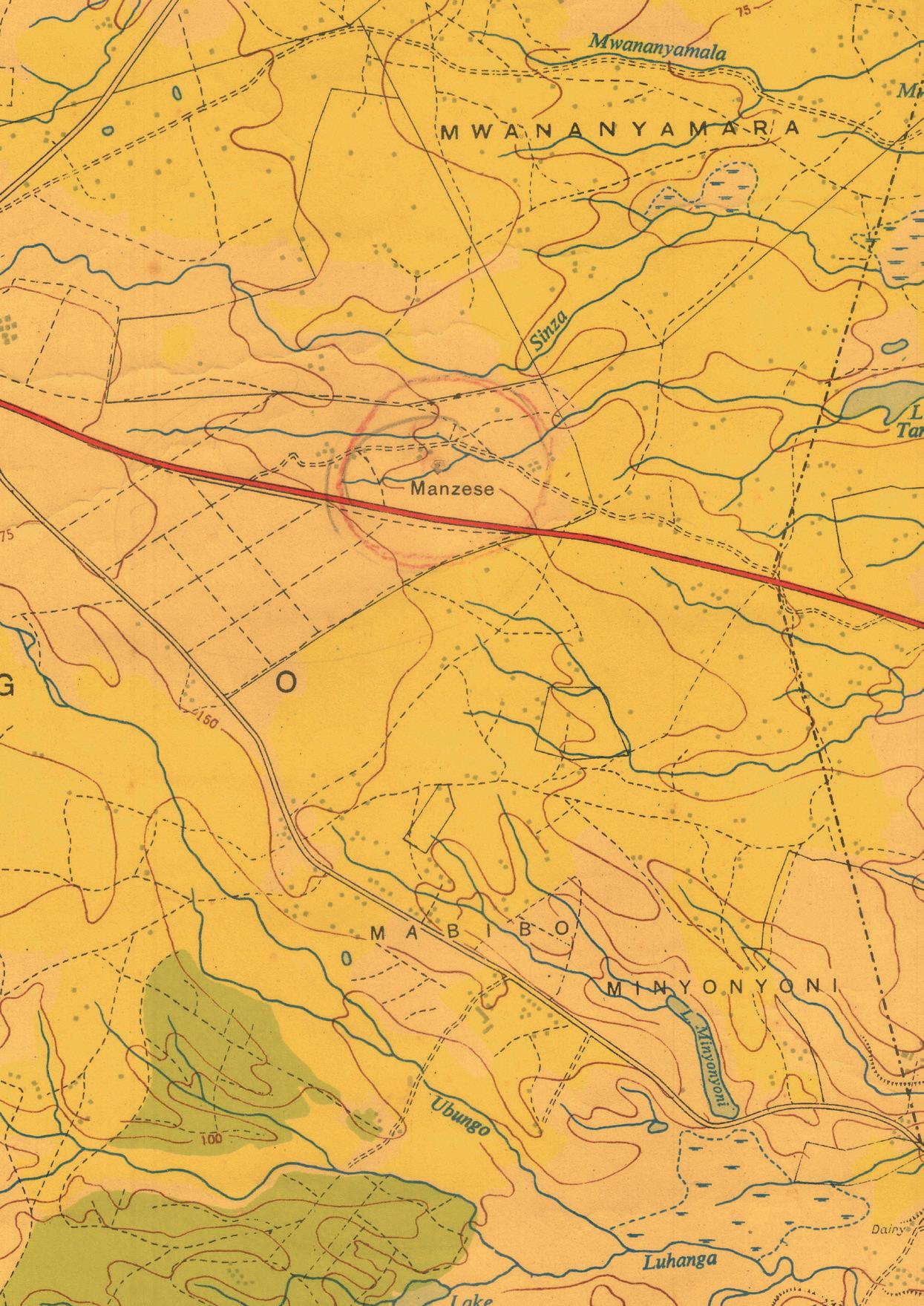
to camera, locals in their late teens and early 20s are asked if they have heard of city lakes such as Makulumula, Minyonyoni, Alimaura, Tenge and Magomeni. The question is met with blank faces and embarrassed laughter. “Are they real lakes,” one responds.
The film also features interviewees a generation or two older. The lakes are very real to them. One 55-year-old man smiles fondly as he remembers early childhood days spent swimming with his friends in the “crystal clear waters” of Lake Makulumula. He says he would regularly swim the length of the tear-shaped lake in the Kijitonyama neighbourhood in the heart of the city. Another older man describes Lake Alimaura as a fertile paradise surrounded by mango and guava trees as well as rice and cashew farms.

Fifty years on, memories are all that remain of the five lakes that were once within Dar’s borders. One was drained for a petrol station to be built in its place while others were used as unofficial rubbish dumps that allowed sediment to build up and take away the lakes’ ability to store water. As the lakes dried up, locals began to build homes on the land. Kijitonyama is now a bustling neighbourhood with many of its tightly packed homes covering where Lake Makulumula once flowed.
At just 13 minutes long and in Swahili with English subtitles, The Lost Lakes of Dar es Salaam is a short but powerful film. Its director Aika Kirei was born in Dar in the 1980s yet admits she spent most of her life also unaware of the lakes. “In 2018 someone in a WhatsApp group I was part of shared an early geo map of the city that showed the lakes. Like most young people here I had no clue they had existed.”
Aika, a writer and filmmaker who has “always loved telling stories”, was inspired to find out more. She tried to locate the book the map came from and searched records at the University of Dar es Salaam’s geographic department. The paucity of information available only served to further convince her of the need to document this piece of hidden history. “It’s not in the textbooks. I felt that this was information that was going to be lost forever unless I shared it,” she says.
In the following years Aika created the children’s animated series Chiku and Katope and produced Fahari Yetu: Zanzibar Saves its Sea – both awardwinning projects that explored environmental issues – but the lost lakes idea remained on her mind. In 2022 she won financial backing to make the film when she was among the 15,000 storytellers and conservationists worldwide to gain grants from the National Geographic Society’s Fresh Water Initiative – a new funding opportunity to support community-led freshwater protection projects.
To source the living testimonies of lake life in Dar half a century ago that provide such an evocative beginning to the film, Aika approached local government offices to track down people living in the area that were around at that time. As for footage of the lakes themselves, Aika’s camera follows a team of University of Dar es Salaam scientists to a site in the centre of the city. The team point out the

I have always loved natural history programmes, but I’ve never seen African scientists on film before. Not many young filmmakers are doing this. I want to tell more stories like this – our stories.
mandago plants that indicate the presence of a water source, but the busy bird life here is attracted by the piles of rubbish to pick through rather than pools of drinkable lake water. Beyond the marshy ground there is little to the untrained eye that would suggest a lake was ever here.
Aika’s filming of local experts was deliberate. She wanted to show the city has the scientific and intellectual capital to recognise and tackle issues such as these. “I have always loved natural history programmes, but I’ve never seen African scientists on film before. Not many young filmmakers are doing this. I want to tell more stories like this – our stories.”
The university scientists say locals are unaware of how their waste disposal affects the availability of water in residential areas. While National Geographic’s World Water Map – created as part of the five-year Fresh Water Initiative to map the world’s water shortages – does not include Dar es Salaam among its 22 critical water scarcity hotspots, the city has experienced supply issues in recent years. Drops in water levels of the Ruvu river, Dar’s main source of water, create challenges compounded by the loss of its lakes.



Cliff Resort & Spa, Zanzibar
Zanzibar is a diver’s dream. The coral reefs teem with colourful life and the water here is clear warm. Sea Cliff partners with Scubafish, a Padi 5-star dive centre located in Matemwe, on the north-east of the island. It is close to the famous Mnemba Island, which is part of marine conservation area and one of the few places to see whale sharks as well as dolphins, reef sharks and even humpback whales during their migratory season.
For more marine adventures visit Zanzibar’s south coast and Kizimkazi, which is known as the ‘Dolphins Village’. Here there is the chance to board a dhow and set out into the Menay Bay Conservation Area in search of dolphins. Guests have sometimes been lucky enough to swim and snorkel with these beautiful animals. The boat trip takes approximately two hours and includes snorkelling and lunch. Kizimkazi is also home to one of Zanzibar’s newest tourist attractions – a natural cave in which you can swim with sea turtles.
For wildlife adventures on land head to Jozani Forest, a 50 sq km national park that is home to endemic species such as the Zanzibar red colobus monkey, the critically endangered Zanzibar leopard, and the Zanzibar servaline genet, which was first discovered here just 20 years ago.
All excursions can be booked onsite at the Sea Cliff Resort & Spa Zanzibar tours desk.

• Supported the launch this year of the Watoto Wetu Campaign to provide medical and emotional care for children battling cancer. We helped fund the launch and provided the venue.
• Support Wasikie – a radio programme made by and for women. It broadcasts on Mjinifm every Saturday from 2pm to 4pm broadcasting shows that empower women in Tanzania.
• Helped out with much-needed maintenance at Uhuru Mchanganyiko, a primary school in Dar es Salaam that caters to students with diverse learning needs, including those with visual impairments, deaf-blindness, and learning disabilities.
• Sea Cliff are among the sponsors of TZ Punchline - a comedy venue in Dar es Salaam that mentors the new generation of Tanzanian stand-up comedians.
• Donated blankets for pupils at Ole Sokoine Secondary School in Arusha. The school is in the remote Monduli mountains where it gets very cold.
• Sea Cliffs buy a goat every year to race in the Dar Rotary Goat Races. All the bets collected by the Rotary Club of Dar es Salaam for this goat’s races goes to charity.

In 2025, Sea Cliff Zanzibar supports a different CSR project every month.
January: Donation of TSH 1,000,000 towards the Kama Village School community in Mangapwani, Zanzibar.
February: Donation to orphanage centre.
March: Organising an Iftar dinner for the orphans as well as a Women’s Day celebration.
April: Easter dinner with children from the orphanage.
May: Organising a beach cleanup and celebrating Labour Day at Sea Cliff Zanzibar.
June: Celebrating the start of the Id Al Adha Islamic festival on June 6 and marking Environment Day on June 5.
July: Organising a blood donation event.
August: Putting on a lunch for local elders and retired people.
September: Taking part in marathon for charity.
October: Events for Breast Cancer Awareness month.
November: Tree-planting and road-cleaning.
December: Christmas dinner for the orphans.

the stage. Across town in Mikocheni, Nafasi Arts Space hosts regular live shows with music ranging from traditional taarab – a Swahili music genre that can be traced back to the early 19th century – to singeli, the frenetic DIY dance genre born on the streets of Dar. Nafasi also hosts the annual two-day arts festival Wikiendi Live that features musical acts from Tanzania and beyond. This year’s event takes place on September 26 and 27.
Tanzanians love their football, and Dar es Salaam is home to some of the mostly hotly contested matches in Tanzanian Premier League. Two of the league’s best performing clubs, Simba and Young Africans, both hail from Dar neighbourhood Kariakoo. When the two teams play each other in what has become known as the ‘Dar derby’, the city is transfixed. Running is also popular here with the wealth of beaches becoming jogging tracks. Jogging clubs can be a great motivator, provide security for those intimidated by running alone and are a great way to meet new people. The global rise in padel tennis and pickleball has hit Dar. The Racket Sports Club has two
venues in the capital – in Masaki and Ghana Street in the city centre. The clubs have memberships, but nonmembers can book courts and play at a slightly higher price.
There are a handful of multiplex cinemas in Dar es Salaam. They predominantly screen blockbuster movies from Europe, the US and India. However, the Tanzanian film industry is growing and recently there have been a few domestic releases – such as ‘Binti’ and last year’s ‘The Christmas Run’ – that have been released on the big screen. For a true local movie experience, head to one of the hundreds of video bandas. These small, informal cinemas – little more than a few rows of chairs and a boxy old television – screen DVDs of foreign films with a dubbed Swahili ‘commentary’ rather than translation. Sometimes the commentary is provided live by a DJ who interacts with the crowd. Don’t miss.
The airbrushed shopping experience of tourist-targeted centres such as the Slipway and Milimani City
Mall has its place, but there are other down-to-earth options. Chief among them is the colossal Kariakoo Market, where you can bargain for just about everything you need – from stacks of fresh fruit, vegetables and pieces to household essentials. Its sprawling size can be intimidating at first, but the more you’ll visit you’ll become familiar with its layout. For example, the area between the Livingstone Hotel and Lumumba Garden Hotel is where you’ll find most of the mitumba –second-hand clothing – stalls. It pays to arrive early and get access to the freshest produce. You’ll need to set your alarm clock even earlier for the Kivukoni fish market as boats arrive laden with their overnight catch at daybreak. Then the selling starts with eager customers including representatives from some of Dar’s biggest hotels and restaurants on the look-out for the best fish and seafood for their menus. A far calmer market experience is available on the last Saturday of every month when the Swahili Farmers’ Market takes over the courtyard of the Oyster Bay Shopping Centre. You’ll find organic produce from farms across Tanzania as well as hand-baked bread, and local honey and coffee.
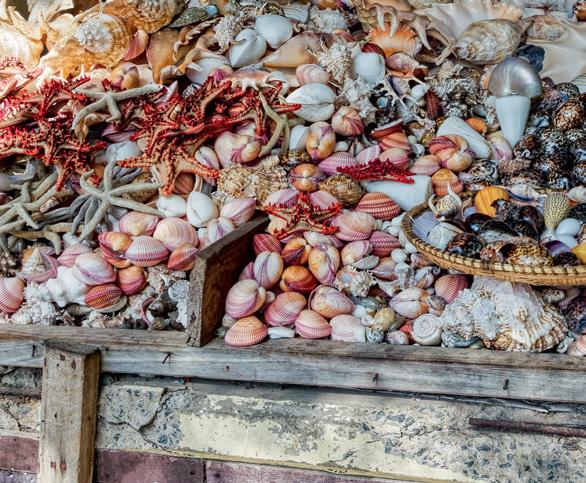





WHITE SANDS RESORT & CONFERENCE CENTRE, Dar es Salaam
Visible from the shores of the White Sands Resort and reachable by a 15-minute boat ride every day from the hotel, Mbudya Island is a pristine gem within the Dar es Salaam Marine Reserve. Here’s how to make the most of one of Dar’s most popular day trips.
Snorkelling in the coral reef
Make sure you pack your swimming gear ahead of your trip because snorkelling here is special. Mbudya is one of four offshore islands within the Dar es Salaam Marine Reserve. The protected waters are sanctuaries for endangered species. The largest coral reefs are to the north and west sides of the island and these biodiversity hotspots are full of marine life such as sea cucumbers, octopus, giant clams, rock crabs, cushion stars, and host of colourful reef fish. Snorkels and flippers are available for hire on the island. You can swim out from the beach to reefs that ring the shore or boats will take you to reefs further out.
Mbudya Island is an idyllic place to soak up some rays. Simply lie back and let your ears be soothed by the gently lapping waves and enjoy the eye balm of the cerulean skies, and crystalline waters of the Indian Ocean.
Relaxation goals met! When you’ve had enough vitamin
D you can always cool off with some vitamin sea and a dip in the water or grab some shade under one of the thatched cabanas that dot the beach.
Don’t just spend the day at the ferry drop-off point at the northwestern tip of the island. At low tide you can walk the beach around the entire island. It is also worth

venturing into the Mbudya’s inland forest. Not only do the trees provide welcome shade they are also support some rare wildlife. Coconut crabs love the wealth of palm trees on the island. The largest land arthropod in the world is especially eye-catching when, in the absence of food on the ground, it climbs the palm to pinch off coconuts with its enormous claws. The island’s beaches have also been nesting sites for the critically endangered hawksbill turtle.
Mbudya Island is a feast for the eyes. You’ll no doubt want to take plenty of pictures but be warned drones and DLSR cameras are banned. Mobile phones with cameras are fine. The island is arguably at its most photogenic at sunset. With the last ferry home at 7pm, there is time to take in ‘the golden hour’. You’ll be glad you did.


You are welcome to bring a picnic with you to Mbudya, but those in the know take advantage of the vendors who set up barbecues on the beach for visitors. The grilled delights on offer include freshly caught whole fish and lobster. It’s delicious, affordable and a prime Mbudya experience. Tuck in!


The other islands in the Dar es Salaam Marine Reserve
(Kisiwa cha Bongoyo, in Swahili)
This island to the south of Mbudya is another popular Dar day trip with most boats leaving from the Slipway harbour in Msasani Bay. Unlike Mbudya it has a predominantly rocky shore so its two beaches can get crowded. The Indian Ocean has penetrated the northern shore of the island, creating a tidal lagoon with mangrove forest.
(Kisiwa cha Fungu Yasini, in Swahili)
The majority of this uninhabited island north of Mbudya is an underwater coral reef, but at low tide a sand bank is revealed. On the west and north sides of the lower intertidal zone, there is a lot of sea grass mixed in with patches of coral.
(Kisiwa cha Pangavini, in Swahili)
This uninhabited island to the west of Mbudya is the smallest in the archipelago. It measures just over 2 sq km and is only 250 metres long. It has a rocky coastline without beaches. The beauty of Pangavini Island is that it is the nightly habitat for the birds that fly over the city of Dar es Salaam during the day. It also serves as a nesting habitat for the birds and plays a similar role for rats and reptiles.

94
The total number of guest rooms at Sea Cliff Hotel. All are beautifully furnished with most rooms recently renovated. Each room is set up for both business and pleasure stays.
13
The number of rooms that make up the exclusive executive floor. Most of the spacious and luxurious rooms feature spectacular views over the Indian Ocean. Seven are executive suites, and there is also a Presidential Suite.
6
Sea Cliff offers six fully equipped meeting rooms. The hotel’s business facilities also include conference and banqueting facilities.
120
The Bahari Vista venue can accommodate up to 120 people. With an ocean-view outdoor terrace and lawns, the venue is an unforgettable location for smaller weddings and other celebrations.
180 degrees
The spectacular view of the Indian Ocean afforded by the terrace at Sea Cliff’s Karambezi Café stretches out before your eyes. The




food is just as spectacular with fresh sea food, steaks, burgers and tasty pizzas.
1987
The date Sea Cliff’s Alcove Restaurant was established in Dar es Salaam. Over the following four decades it has built a reputation for high-quality authentic Indian and Chinese cuisine prepared with passion by master chefs.
16
The number of table games at the Sea Cliff’s onsite casino. Other features include 140 slot machines and a non-smoking gaming area, the first of its kind in Tanzania.
19 km
The distance between the Sea Cliff and Julius Nyerere International Airport. Transfers can be arranged through the hotel.
11
Number of amenities available for guests at Sea Cliff Hotel. These include two restaurants, two bars, a spa, a salon, a gym, a pool, a gift shop, a jewellery shop and a business centre.
KARAMBEZI CAFÉ AND ALCOVE RESTAURANT
Sea Cliff Hotel, Dar es Salaam

We speak to the culinary creatives behind the Sea Cliff Hotel’s top-class restaurants – Karambezi Café and Alcove Restaurant.
‘I LOVE WHAT I DO AND YOU CAN SEE IT IN MY FOOD’
MUHAMMAD JUMA BATLETY, HEAD CHEF, KARAMBEZI CAFÉ
Q: What are your earliest food memories?
My mother’s cooking. She cooked us a chicken biryani that was amazing and unforgettable. She was the inspiration for me to learn how to cook.
Q: What is your culinary background and training?

My culinary journey began with a three-month course at Institute Worldwide [Dar-based hospitality management college] before a hotel management course as a chef. Upon completion of my training, I was hired by Karambezi Café in 2016 as a trainee. After my years of service and constant selfdevelopment the company gave me the opportunity to lead the kitchen team as a senior chef in 2023. Two years into this role I’m loving each and every day
Q: What are your proudest achievements as a chef?
To be part of the team that creates the menus, share my expertise and ideas, know the different types of foods, recipes and to gain more experience. Another great achievement was last year, where I was able to showcase my cuisine to the Chaîne des Rôtisseurs. The international association of gastronomy presented me with a certificate of recognition for outstanding craftsmanship.

Q: What are some of your signature dishes?
The seafood platters, lobster thermidor, prawns stuffed lobster, chocolate molten cake, black forest cake, just to name a few.
Q: How do you incorporate local, seasonal ingredients into your menu?
We get a daily supply of all our produce. We use only the best ingredients in all our sauces, marinades, garnish, and seasoning. Seafood as well is something we don’t compromise on. Each day we get only the best and freshest supply for our customers.
Q: Can you give us an example of how you have given a traditional
dish a modern update?
The Karambezi menu features Tanzanian staple plantain served with a twist of lemon juice and kachumbari and cassava leaves cooked with a coconut sauce.
Q: What makes the Karambezi dining experience stand out?
We have live cooking stations where diners can see their meals being prepared and interact with the kitchen staff.
Q: What kind of dining experience to do you hope to create for customers at Karambezi?
Definitely not fine dining. That’s not who we are. The dining I aim for here is the smart but casual kind that leaves the best taste in
our customers’ mouths and makes them crave more. We get a lot of repeat customers.
Q: What advice would you give to aspiring chefs?
To have the right attitude and be a strong leader. Try to be creative when you feed people from all walks of life. If you love what you do it will be seen in your food.


Q: What are your earliest food memories?
Eating spicy Indian curries with my family as a kid. The bold flavours stuck with me. My mother cooked for the whole family every day.
Q: What is your culinary background and training?
I grew up cooking Indian dishes at home, then trained under chefs in India in various restaurants in the state of Maharashtra.
Q: What are your proudest achievements as a chef?
Keeping The Alcove’s reputation strong. As a brand it has existed since 1987. It is wonderful to see customers return again and again.
Q: What has inspired you in creating the menu at The Alcove?
Dar’s diverse Indian and expat community and fresh coastal ingredients push me to blend authentic food with local spices.
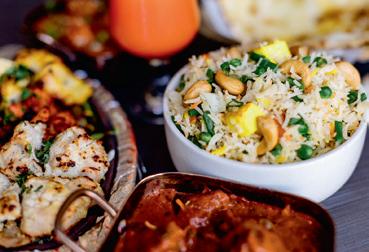
‘I
MAJIBAR KHAN, HEAD CHEF, ALCOVE RESTAURANT

Q: What are some of your signature dishes?
Tandoori prawns, butter chicken, and chilli paneer. All are big hits with our guests.
Q: How do you incorporate local, seasonal ingredients into your menu?
I use seafood straight from the market, vegetables which are all organic and fresh, and seasonal spices. Ingredients are everything.
Q: Can you give us an example of how you have given a traditional dish a modern update?
Our coconut fish curry, for example, uses classic Indian spices mixed with distinctly African coconut.
Q: What kind of atmosphere do you like to create in your kitchen?
Very fast-paced but calm, with teamwork and passion. Attitude is important in a kitchen, and we only have team players.
Q: What current culinary trends are you interested in exploring? Fusion flavours. I like the idea of mixing Indian spices with East African street food.
Q: What kind of dining experience do you hope to create for customers at The Alcove?
Warm, welcoming, with bold tastes that feel like a trip to India or… Nepal, which is where our Indochinese food originates from.
Q: What advice would you give to aspiring chefs?
Stay curious, master the basics, and don’t fear mistakes as they are what teach you the most. Do your best daily. It pays off.
WHITE SANDS RESORT & CONFERENCE CENTRE, Dar es Salaam
Beach and bush safaris among the rewarding adventures
White Sands’ enviable Mbezi Beach location 20 km above Dar es Salaam makes it an ideal starting point for trips north along Tanzania’s coast. It’s a rarely visited but rewarding stretch of the country that includes the only national park on the East African coast along with port towns rich in Swahili history.
Just three hours’ drive from White Sands, Saadani National Park is where beach meets bush. East Africa’s only coastal game reserve encompasses a 20 km stretch of Indian Ocean coastline as well as 1,100 sq km of mangrove swamps, jungle, and savanna inland. Gazetted in 2005, the national park ensures these unique environments – from coral reef to coastal forest – and the wildlife they support are protected. Game drives will reveal thriving populations of elephant, buffalo, and giraffe. The park is also home to lions, leopards and varieties of antelope. Unlike many national parks, human communities live within Saadani’s boundaries so there are plenty of opportunities for visitors to experience local life from the Maasai roaming the savannah to the fishing villages on the coast. The beaches here are a breeding site for endangered green turtles, and elephants, lions and other wild animals have been known to wander the sands here. The coastline also provides the perfect spot for respite and relaxation after wildlife adventures inland with the park’s beachside lodge offering food and accommodation along with water sports options. A safari like no other.

Must-try experience: The mangrove-lined Wami River is the lifeblood of the park. There are opportunities for unforgettable river safaris that reveal the largest population of crocodiles in Tanzania as well as a huge variety of marine and riverine birds.
Stone Town in Zanzibar may grab the spotlight when it comes to historic Swahili ports, but Pangani also has a storied trading past going back centuries. It was once among the largest ports between Bagamoyo and Mombasa and, sadly, a major stop for slave-trading caravans from Lake Tanganyika and an export point for ivory. In the old part of town, near the Pangani River, merchant homes and colonial era buildings are crumbling architectural reminders of these times. Unlike in Stone Town, though, the ancient streets do not still pulse with crowds of tourists. Travellers that make it as far as Pangani discover a non-commercial seaside experience with the crowd-free serenity serving to bring the beauty of the white beaches, palm

trees and crystalline ocean here into sharper focus. Wander the endless white sands, take a trip with a local fisherman on a ngalawa (a traditional wooden double-outrigged canoe) for a picnic on a sand bar or go snorkelling among the pristine coral reefs of the marine reserve that rings off-shore island Maziwe. It is also possible to take a motorised dhow across to Zanzibar Island.
Must-try experience: An hour’s drive north of Pangani are the Tongoni Ruins, the remains of a 15th century coral stone mosque and tombs that are the most extensive of their kind on the East African coast
Bagamoyo
There are more opportunities to step back in time and experience a beach break steeped in Swahili culture in Bagamoyo. The town was once one of the most important trading ports on the East African coast. As it is on Zanzibar island, the historic centre of Bagamoyo is known as Stone Town – or ‘Mji Mkongwe’ in Swahili – because of its ancient, still extant buildings that were

The fish market, situated on the site of the old slave market, is a hive of activity during daily auctions of the fresh catch each afternoon.
constructed out of local coral rock, a sedimentary stone made from compressed coral and shells. Among the centre’s tightly packed streets you’ll find once opulent homes featuring carved wooden doors that flaunted their former owners’ trading prestige and wealth. Striking buildings from Bagamoyo’s colonial past – it was the headquarters of German East Africa from 1886–1891 – can also still be found, including Liku House, which served as the German administrative headquarters, the German customs house on the beach, and the Old Boma, which was renovated between 2010 and 2014 and now contains a museum detailing the town’s complex past. There is still a bustle about Bagamoyo today. The fish market, situated on the site of the old slave market, is a hive of activity during daily auctions of the fresh catch each afternoon. On the beach you’ll find dhow sailboat builders hard at work using skills passed down through generations.
Must-try experience: Bagamoyo is at the heart of cultural preservation in Tanzania. It was on the

outskirts of the town that the Zawose family set up their musical commune playing and preserving the unique music of the Wagogo tribe from central Tanzania. Generations of the family have found musical fame around the world, but many local performances take place at the Bagamoyo Arts and Cultural Institute, which was set up to pass on the artistic traditions of the country to a new generation of students through programmes in music, dance, drama and art. Attending a concert here is an unforgettable insight into the artistic soul of Tanzania.
This northernmost port city in Tanzania was considered of strategic importance during colonial times and was initially considered as the capital of German East Africa. However, it was to become overshadowed by Dar es Salaam’s rise as the country’s commercial capital and largest port. In recent years, significant investments in infrastructure improvements have boosted Tanga port’s capacity and it now serves as a primary entry point for goods destined for the northern regions of Tanzania, including Arusha, Kilimanjaro, and Manyara. Tourism is still underdeveloped but that means those that venture here have the region’s flawless white sand beaches almost to themselves. The coastline includes the Tanga Coelacanth Marine Park, a protected
stretch of the Indian Ocean where some of the world’s rarest and most mysterious underwater life such as the seagrass-grazing dugong and the prehistoric coelacanth fish have been recorded. The park is a popular destination for snorkelers and divers to see its coral reefs, colourful fish, and sea turtles. Within the park, Tanga Bay is home to Toten Island, with its ruined mosques and German colonial buildings. Inland, you can explore the limestone Amboni Caves, which are filled with stalagmites and stalactites and are of great spiritual significance to locals.
Must-try experience: The journey north does not have to end at Tanga. The town is the gateway to inland adventures in the Usambara Mountains. This biodiversity hotspot is a picturesque, lush landscape of forests and cliffs that is home to numerous endemic species like the Usambara eagle-owl and African violet.

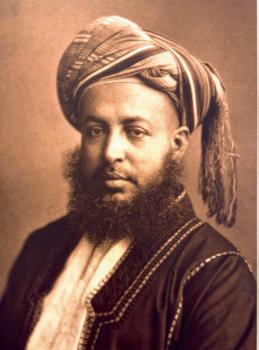
The Sea Cliff Zanzibar Resort & Spa loves to share the rich heritage of its home islands with guests. Among the cultural trips it organises is one that explores the legacy of more than a century of Omani rule. Step back with us to the time of the Sultans.

For over a century, the dominion of the sultanate of Zanzibar extended along the East African coast from Somalia in the north to Mozambique in the south and stretched as far inland as Lake Malawi. At its heart was Zanzibar Island and its capital Stone Town. This trading empire formed the roots of the cosmopolitan commerce and culture of the Swahili people of the Indian Ocean coastline, but it came at a terrible human cost with hundreds of thousands of Africans enslaved to work for the ruling Arab elite.
Stone Town today is a living museum that reveals in architectural remnants its former wealth and influence as well as the infamous practices that fuelled it.
But let’s go back to the beginnings of the sultanate of Zanzibar and look more closely at some of the stand-out sultans who ruled during this crucial part of East African history.
Zanzibar has attracted international visitors since the early centuries with its large, sheltered harbour at what would become Stone Town offering refuge for sailors on Indian Ocean voyages from China, Persia and Arabia.

Barghash took responsibility for modernising Stone Town with prominent buildings erected during his reign.
The Portuguese were the first Europeans to establish a presence in Zanzibar – and the first to introduce slavery here. They arrived in the late 15th century and retained the archipelago as part of their East African empire for the next near two hundred years.
Omani Arabs – who were building a thriving sea-going commercial empire – ousted the Portuguese from the resources-rich islands in the late 17th century. Omani rule was established over Zanzibar in 1698 and the archipelago became part of a thriving Omani Empire.
Under Omani rule, the most fertile land was handed over to Omani aristocrats and an international commercial empire was created along the East African coast. Each year, fleets of dhows would bring in iron, cloth, sugar and dates from Arabia, Persia and India.

Then the vessels would be laden with copal tree resin for incense, cloves, coconuts, rice, ivory, and slaves for the return journey.
Oman’s strategic location and maritime history made it a powerful trading power in the region, however it was not until the mid-19th century when Sultan Said bin Sultan moved his capital to Zanzibar that the island became a major centre of Omani trade and commerce.
Said bin Sultan was the ruler of Muscat and Oman and of Zanzibar from 1806 to 56. However, defending Oman against its many would-be conquerors meant he did not set foot on Zanzibar soil until the year 1828.
In 1840 Said bin Sultan moved his royal household to Zanzibar and
declared it the new capital of his empire. The Sultan’s Palace, which still stands on the Stone Town seafront, was constructed between 1827 and 1834 for Said bin Sultan and was home to all subsequent sultans until the Revolution.
The Sultanate of Zanzibar reached the peak of its wealth under Said bin Sultan. Lucrative income avenues included the trading with interior communities for ivory and slaves.
Said had 36 children. On his death in 1856, his third son, Thuwaini bin Said, became Sultan of the Omani Empire, based in Zanzibar. However, the succession caused a family rift that resulted, in 1861, two separate sultanates being created. Thuwaini became the Sultan of Muscat and Oman while son Majid bin Said became the Sultan of Zanzibar.

Majid bin Said
The first Sultan of Zanzibar never expected to be ruler. He had two older brothers, but they died before their father. The fairskinned Majid – his mother was a concubine from Circassia, now part of the Russian Federation – came to power aged 22. The sultanate continued to soar until Majid’s untimely death in 1870 at the age of just 36.
Barghash bin Said
Majid’s marriage produced only one daughter so he was succeeded as Sultan by his halfbrother, Barghash, who believed he had a claim to the throne when Said died.
The family feuding led to Barghash being exiled in Bombay, but he eventually returned upon Majid’s death to become the Sultan of Zanzibar. Barghash took responsibility for modernising Stone Town with prominent buildings erected during his reign including Beit-El-Ajaib (House of Wonders), Zanzibar’s first building with electricity. He is also credited with the building of new roads, public baths, parks, government buildings and hospitals.

Sayyida Salme was the youngest of the 36 children of Said bin Sultan. While her brothers were groomed for power, she lived a cloistered existence within the palace walls. It was not the life she wanted. Secretly she would copy the Arabic alphabet and teach herself to write. Isolated from her family she struck up a friendship with a young German merchant called Rudolph Heinrich Ruete. They became lovers and Salme fell pregnant. Fearing for her life, Salme escaped by ship to Yemen, where Rudolph joined her before the pair settled in Germany. Here, Salme changed her name to and began a new life. During this time, she wrote Memoirs of an Arabian Princess. The book is thought to be the first known autobiography of an Arab woman and there is a museum dedicated to her extraordinary life inside the Emerson on Hurumzi Hotel in Stone Town.
Britain had started to develop a relationship with the sultans during Majid’s rule as its imperial interest in Africa grew. Those ties tightened with Barghash. The second Sultan, who ruled from 1870 to 1888, was instrumental in the abolition of the slave trade in Zanzibar, signing two agreements with Britain.
In 1890 Zanzibar became a British protectorate with the sultan’s authority trimmed down.
Under the protectorate, the British administered the island on behalf of the sultan, who remained the sovereign. However, after the death of the sultan Hamad ibn Thuwayn in August 1896, his nephew, Khalid ibn Barghash, seized the throne.
As the only son of the late Sultan

Barghash, Khalid saw himself as the rightful successor. His reign lasted three days before it was cut short by the Anglo-Zanzibar War –a 38-minute skirmish concluded by a British bombardment of the Sultan’s palace that is on record as the shortest war in history.
After Khalid’s defeat, the Britishsupported candidate, Hamud ibn Mohammed, assumed the throne in December 1911, and served until his death in October 1960. .
In 1963 the sultanate regained its independence, becoming a member of the British Commonwealth. In January 1964 the Zanzibar Revolution overthrew the sultanate and established a republic. The age of the Sultanate of Zanzibar was over, but the Omani influence along the Swahili coast remains deeply ingrained.
Zanzibar’s primary islands boast a mix of ancient culture, stunning nature, and some of the world’s best beaches. Whether you’re looking to immerse yourself in Swahili culture, unwind in nature, or indulge in luxury, Zanzibar offers something for everyone. Here’s a guide to help you choose the best island for your next adventure.
Unguja is the largest and most developed of Zanzibar’s islands. At 1,666 sq km, it offers a range of luxury accommodations and activities, making it the go-to destination for those seeking a blend of culture and comfort.
Unguja is known for its high-end resorts, especially in areas like Paje and Nungwi, which maintain a balance between fishing village vibes and beach resort life. Inland, Jozani Forest, Zanzibar’s only national park, offers walking trails and canoe trips through mangrove swamps.
Stone Town is a UNESCO Heritage Site with ancient architecture and a vibrant local culture. Wander through its winding streets, soak up Swahili culture, and visit the Old Slave Market. Don’t miss a taarab music concert, bustling markets, or international events like the Sauti za Busara music festival held in the Old Fort amphitheatre.

Pemba remains largely untouched by tourism, providing a serene atmosphere for those looking to disconnect. It offers great opportunities for swimming, kayaking, and exploring traditional villages. The Pemba Channel is considered one of East Africa’s top diving spots, featuring untouched coral reefs.
The Ngezi Nature Reserve is a must-visit. This tropical forest offers guided tours, where you can spot birds, vervet monkeys, and even the endemic Pemba scops owl. For a truly magical experience, take a night tour to see the island’s nocturnal creatures like the giant Pemba flying fox.
Chumbe Island
Pemba
Located 80 km northeast of Unguja, Pemba is known for its lush, green landscape, clove farms, and coral reefs. It’s a peaceful island that’s perfect for nature lovers.
This private island, a few kilometres off Unguja, is a nature reserve and eco-lodge developed with sustainability in mind.
Chumbe Island is an eco-tourism haven, powered by



solar energy, rainwater harvesting, and composting toilets. The island is home to rare wildlife, including Ader’s duiker and roseate terns.
The island’s famous coconut crabs are one of its strangest residents. Guests can take a walk after dinner to spot these giant creatures searching for coconuts, using their powerful claws to climb palm trees and feast on their fruit.
Not strictly part of Zanzibar – it is the largest island in the Mafia archipelago – Mafia Island is the perfect spot for marine life enthusiasts. The island’s protected waters are home to whale sharks and other sea giants.
The island offers some of the best diving in the world, with crystal-clear waters and abundant marine life. From September to February, the whale sharks gather in these plankton-rich waters, making it one of the longest seasons for swimming with these majestic creatures.

Wander through its winding streets, soak up Swahili culture, and visit the Old Slave Market.
Mafia Island is rich in history, with ruins like Kisimani Mafia, which date back to the 13th century. Explore the remains of this ancient trading hub and imagine the island’s past as a key stop in Indian Ocean maritime trade.
A tiny private island just off Unguja, Mnemba offers exclusive luxury at the andBeyond resort.
Mnemba is the epitome of barefoot luxury. With only 24 guests at a time, it’s an intimate escape with a focus on personal service. The coral reefs around the island provide excellent snorkelling and scuba diving.
Mnemba is home to green turtles, and during hatching season in February and March, guests can witness the incredible sight of hatchlings making their way to the sea. The island’s pristine beaches and crystal-clear waters make it a perfect, secluded retreat.

hotelwhitesands.com
Information & Reservation
Please call: +255 (0)758 818 696
Email: info@hotelwhitesands.com
Sales & Marketing
Email: marketing@pearlsunhotels.com

seacliffzanzibar.com
Information & Reservation
Please call: +255 (0)767 702 241-9
Email: reservations@seacliffzanzibar.com
Sales & Marketing
Email: marketing@pearlsunhotels.com

hotelseacliff.com
Information & Reservation
Please call: +255 (0)764 700 600
Email: information@hotelseacliff.com
Sales & Marketing
Email: marketing@pearlsunhotels.com

seacliffcourt.com
Information & Reservation
Please call: +255 (0)222 601 967
Email: info@seacliffcourt.com
Sales & Marketing
Email: marketing@pearlsunhotels.com

